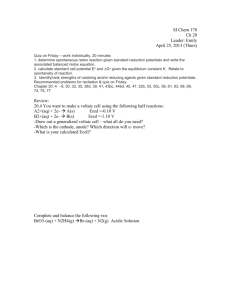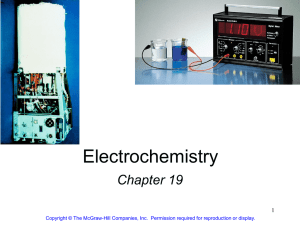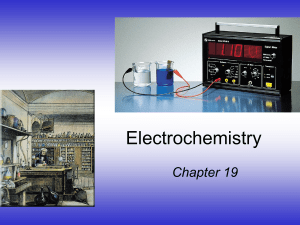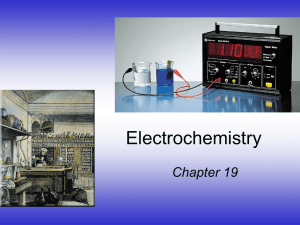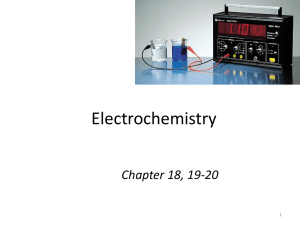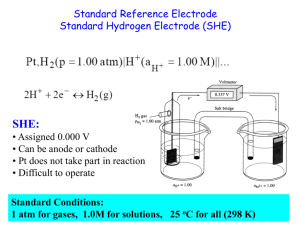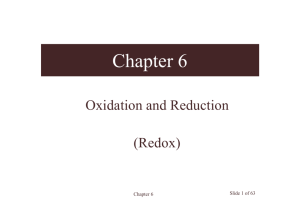Chap 20(E'Chem),
advertisement
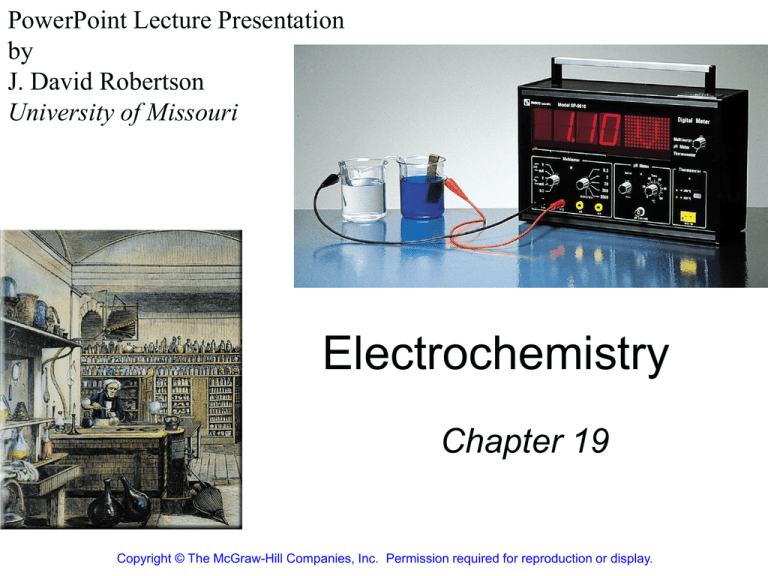
PowerPoint Lecture Presentation by J. David Robertson University of Missouri Electrochemistry Chapter 19 Copyright © The McGraw-Hill Companies, Inc. Permission required for reproduction or display. Electrochemical processes are oxidation-reduction reactions in which: • the energy released by a spontaneous reaction is converted to electricity or • electrical energy is used to cause a nonspontaneous reaction to occur 0 0 2+ 2- 2Mg (s) + O2 (g) 2Mg O2 + 4e- 2MgO (s) 2Mg2+ + 4e- Oxidation half-reaction (lose e-) 2O2- Reduction half-reaction (gain e-) 19.1 Oxidation number The charge the atom would have in a molecule (or an ionic compound) if electrons were completely transferred. 1. Free elements (uncombined state) have an oxidation number of zero. Na, Be, K, Pb, H2, O2, P4 = 0 2. In monatomic ions, the oxidation number is equal to the charge on the ion. Li+, Li = +1; Fe3+, Fe = +3; O2-, O = -2 3. The oxidation number of oxygen is usually –2. In H2O2 and O22- it is –1. 4.4 4. The oxidation number of hydrogen is +1 except when it is bonded to metals in binary compounds. In these cases, its oxidation number is –1. 5. Group IA metals are +1, IIA metals are +2 and fluorine is always –1. 6. The sum of the oxidation numbers of all the atoms in a molecule or ion is equal to the charge on the molecule or ion. HCO3Oxidation numbers of all the atoms in HCO3- ? O = -2 H = +1 3x(-2) + 1 + ? = -1 C = +4 4.4 Balancing Redox Equations The oxidation of Fe2+ to Fe3+ by Cr2O72- in acid solution? 1. Write the unbalanced equation for the reaction ion ionic form. Fe2+ + Cr2O72- Fe3+ + Cr3+ 2. Separate the equation into two half-reactions. +2 +3 Fe2+ Oxidation: Fe3+ +6 Reduction: Cr2O7 +3 2- Cr3+ 3. Balance the atoms other than O and H in each half-reaction. Cr2O72- 2Cr3+ 19.1 Balancing Redox Equations 4. For reactions in acid, add H2O to balance O atoms and H+ to balance H atoms. Cr2O7214H+ + Cr2O72- 2Cr3+ + 7H2O 2Cr3+ + 7H2O 5. Add electrons to one side of each half-reaction to balance the charges on the half-reaction. Fe2+ 6e- + 14H+ + Cr2O72- Fe3+ + 1e2Cr3+ + 7H2O 6. If necessary, equalize the number of electrons in the two halfreactions by multiplying the half-reactions by appropriate coefficients. 6Fe2+ 6Fe3+ + 6e6e- + 14H+ + Cr2O72- 2Cr3+ + 7H2O 19.1 Balancing Redox Equations 7. Add the two half-reactions together and balance the final equation by inspection. The number of electrons on both sides must cancel. Oxidation: 6Fe2+ Reduction: 6e- + 14H+ + Cr2O7214H+ + Cr2O72- + 6Fe2+ 6Fe3+ + 6e2Cr3+ + 7H2O 6Fe3+ + 2Cr3+ + 7H2O 8. Verify that the number of atoms and the charges are balanced. 14x1 – 2 + 6x2 = 24 = 6x3 + 2x3 9. For reactions in basic solutions, add OH- to both sides of the equation for every H+ that appears in the final equation. 19.1 Galvanic Cells anode oxidation cathode reduction spontaneous redox reaction 19.2 Galvanic Cells The difference in electrical potential between the anode and cathode is called: • cell voltage • electromotive force (emf) • cell potential Cell Diagram Zn (s) + Cu2+ (aq) Cu (s) + Zn2+ (aq) [Cu2+] = 1 M & [Zn2+] = 1 M Zn (s) | Zn2+ (1 M) || Cu2+ (1 M) | Cu (s) anode cathode 19.2 Standard Electrode Potentials Zn (s) | Zn2+ (1 M) || H+ (1 M) | H2 (1 atm) | Pt (s) Anode (oxidation): Zn (s) Cathode (reduction): 2e- + 2H+ (1 M) Zn (s) + 2H+ (1 M) Zn2+ (1 M) + 2eH2 (1 atm) Zn2+ + H2 (1 atm) 19.3 Standard Electrode Potentials Standard reduction potential (E0) is the voltage associated with a reduction reaction at an electrode when all solutes are 1 M and all gases are at 1 atm. Reduction Reaction 2e- + 2H+ (1 M) H2 (1 atm) E0 = 0 V Standard hydrogen electrode (SHE) 19.3 Standard Electrode Potentials 0 = 0.76 V Ecell 0 ) Standard emf (Ecell 0 0 = E0 Ecell cathode - Eanode Zn (s) | Zn2+ (1 M) || H+ (1 M) | H2 (1 atm) | Pt (s) 0 = E 0 + - E 0 2+ Ecell H /H2 Zn /Zn 0 2+ 0.76 V = 0 - EZn /Zn 0 2+ EZn /Zn = -0.76 V Zn2+ (1 M) + 2e- Zn E0 = -0.76 V 19.3 Standard Electrode Potentials 0 = 0.34 V Ecell 0 0 = E0 Ecell cathode - Eanode 0 = E 0 2+ 0 Ecell Cu /Cu – EH +/H 2 0 2+ 0.34 = ECu /Cu - 0 0 2+ ECu /Cu = 0.34 V Pt (s) | H2 (1 atm) | H+ (1 M) || Cu2+ (1 M) | Cu (s) Anode (oxidation): H2 (1 atm) Cathode (reduction): 2e- + Cu2+ (1 M) H2 (1 atm) + Cu2+ (1 M) 2H+ (1 M) + 2eCu (s) Cu (s) + 2H+ (1 M) 19.3 • E0 is for the reaction as written • The more positive E0 the greater the tendency for the substance to be reduced • The half-cell reactions are reversible • The sign of E0 changes when the reaction is reversed • Changing the stoichiometric coefficients of a half-cell reaction does not change the value of E0 19.3 What is the standard emf of an electrochemical cell made of a Cd electrode in a 1.0 M Cd(NO3)2 solution and a Cr electrode in a 1.0 M Cr(NO3)3 solution? Cd2+ (aq) + 2e- Cd (s) E0 = -0.40 V Cd is the stronger oxidizer Cr3+ (aq) + 3e- Cr (s) Anode (oxidation): E0 = -0.74 V Cr3+ (1 M) + 3e- x 2 Cr (s) Cathode (reduction): 2e- + Cd2+ (1 M) 2Cr (s) + 3Cd2+ (1 M) Cd will oxidize Cr Cd (s) x3 3Cd (s) + 2Cr3+ (1 M) 0 0 = E0 Ecell cathode - Eanode 0 = -0.40 – (-0.74) Ecell 0 = 0.34 V Ecell 19.3 Spontaneity of Redox Reactions DG = -nFEcell DG0 = 0 -nFEcell n = number of moles of electrons in reaction J F = 96,500 = 96,500 C/mol V • mol 0 DG0 = -RT ln K = -nFEcell 0 Ecell (8.314 J/K•mol)(298 K) RT ln K = ln K = nF n (96,500 J/V•mol) 0 Ecell = 0 Ecell 0.0257 V ln K n 0.0592 V log K = n 19.4 Spontaneity of Redox Reactions 19.4 What is the equilibrium constant for the following reaction at 250C? Fe2+ (aq) + 2Ag (s) Fe (s) + 2Ag+ (aq) 0 Ecell = 0.0257 V ln K n Oxidation: Reduction: 2e- + 2Ag 2Ag+ + 2e- Fe2+ Fe n=2 0 0 E0 = EFe 2+/Fe – EAg + /Ag E0 = -0.44 – (0.80) E0 = -1.24 V 0 Ecell xn -1.24 V x 2 = exp K = exp 0.0257 V 0.0257 V K = 1.23 x 10-42 19.4 The Effect of Concentration on Cell Emf DG = DG0 + RT ln Q DG = -nFE DG0 = -nFE 0 -nFE = -nFE0 + RT ln Q Nernst equation E = E0 - RT ln Q nF At 298 E = E0 - 0.0257 V ln Q n E = E0 - 0.0592 V log Q n 19.5 Will the following reaction occur spontaneously at 250C if [Fe2+] = 0.60 M and [Cd2+] = 0.010 M? Fe2+ (aq) + Cd (s) Fe (s) + Cd2+ (aq) Oxidation: Reduction: Cd 2e- + Cd2+ + 2e- Fe2+ 2Fe n=2 0 0 E0 = EFe 2+/Fe – ECd2+/Cd E0 = -0.44 – (-0.40) E0 = -0.04 V 0.0257 V ln Q n 0.010 0.0257 V ln E = -0.04 V 2 0.60 E = 0.013 E = E0 - E>0 Spontaneous 19.5 Batteries Dry cell Leclanché cell Anode: Cathode: Zn (s) 2NH+4 (aq) + 2MnO2 (s) + 2e- Zn (s) + 2NH4 (aq) + 2MnO2 (s) Zn2+ (aq) + 2eMn2O3 (s) + 2NH3 (aq) + H2O (l) Zn2+ (aq) + 2NH3 (aq) + H2O (l) + Mn2O3 (s) 19.6 Batteries Mercury Battery Anode: Cathode: Zn(Hg) + 2OH- (aq) HgO (s) + H2O (l) + 2eZn(Hg) + HgO (s) ZnO (s) + H2O (l) + 2eHg (l) + 2OH- (aq) ZnO (s) + Hg (l) 19.6 Batteries Lead storage battery Anode: Cathode: Pb (s) + SO2-4 (aq) PbSO4 (s) + 2e- PbO2 (s) + 4H+ (aq) + SO24 (aq) + 2e Pb (s) + PbO2 (s) + 4H+ (aq) + 2SO2(aq) 4 PbSO4 (s) + 2H2O (l) 2PbSO4 (s) + 2H2O (l) 19.6 Batteries Solid State Lithium Battery 19.6 Batteries A fuel cell is an electrochemical cell that requires a continuous supply of reactants to keep functioning Anode: Cathode: 2H2 (g) + 4OH- (aq) O2 (g) + 2H2O (l) + 4e2H2 (g) + O2 (g) 4H2O (l) + 4e4OH- (aq) 2H2O (l) 19.6 Corrosion 19.7 Cathodic Protection of an Iron Storage Tank 19.7 Electrolysis is the process in which electrical energy is used to cause a nonspontaneous chemical reaction to occur. 19.8 Electrolysis of Water 19.8 Electrolysis and Mass Changes charge (C) = current (A) x time (s) 1 mole e- = 96,500 C 19.8 How much Ca will be produced in an electrolytic cell of molten CaCl2 if a current of 0.452 A is passed through the cell for 1.5 hours? Anode: Cathode: 2Cl- (l) Ca2+ (l) + 2eCa2+ (l) + 2Cl- (l) Cl2 (g) + 2eCa (s) Ca (s) + Cl2 (g) 2 mole e- = 1 mole Ca C s 1 mol e- 1 mol Ca mol Ca = 0.452 x 1.5 hr x 3600 x x s hr 96,500 C 2 mol e= 0.0126 mol Ca = 0.50 g Ca 19.8 Chemistry In Action: Dental Filling Discomfort 2+ Hg2 /Ag2Hg3 0.85 V 2+ Sn /Ag3Sn -0.05 V 2+ Sn /Ag3Sn -0.05 V
